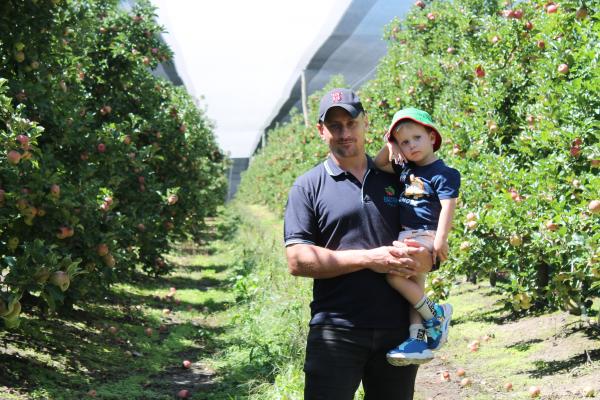By Jess Baker
2020 is over, but the pandemic still does not have a clear end in sight.
Outbreaks are still occurring, Australia’s international borders are still closed, and Granite Belt farms are still suffering a severe labour shortage.
In late February 2021, Queensland horticulture body Growcom reported national crop losses had topped $50 million as a result of insufficient labour for harvest.
While an extraordinary figure, this estimate has likely not come as a surprise to many crop farmers. It may even seem conservative.
Granite Belt strawberry and apple grower Nathan Baronio said his family is on track to lose $750,000 in turnover this strawberry season due to a shortage of pickers.
“We had to spray out and abandon a block of strawberries,” he said.
“We just couldn’t keep up.”
Nathan said the workload is barely manageable, even with a workforce of 120 – including 20 new workers that arrived in December 2020 under the Seasonal Worker Programme trial.
“I could put 40 people into full-time equivalent work tomorrow without a doubt,” he said.
“The unfortunate thing is that picking strawberries is a really hard job.
“We’ve employed about 250 displaced and unemployed Australians, and they’ve given it a red hot go. Some have stuck around for a while, some have quit straight away … but eventually it’s just too hard.”
Like many others, Nathan’s Eastern Colour farm has traditionally relied on working holidaymakers and Pacific Island workers to help get crops to market.
But with international borders firmly shut, growers and governments have had to find alternative solutions.
The Queensland Government last year introduced a Back to Work in Agriculture Incentive Scheme, offering jobless Queenslanders payments of up to $1500 to move to a regional, rural or remote location and take up work on a farm.
And from 1 November 2020, payments of up to $6000 became available through the Australian Government’s Relocation Assistance to Take Up a Job (RATTUAJ) program for Australian workers relocating to take up short-term agricultural work.
Both incentive schemes were mildly successful. Warwick and Stanthorpe Today reported in February 2021 that only 93 Queenslanders had applied for the $1500 incentive in the four months the scheme had been operating.
Similarly, at that time only 756 relocation agreements had been signed since 1 November 2020 through the federal RATTUAJ program.
The Queensland Government has made clear that its main focus for meeting labour shortages is to attract and train Queenslanders, but it has also opted into the Australian Government’s recommencement of the Pacific Labour Scheme and Seasonal Worker Programme.
Under both of these schemes, any agribusiness that wants to recruit an overseas workforce must receive approval from the Australian Government for its recruitment plan and for its on-farm or regional-facility quarantine plan.
Queensland has a cap on the total number of sites where workers are quarantined at any one time, meaning approved employers must coordinate with each other to determine how many overseas workers they can take on.
A spokesperson for the Department of Agriculture and Fisheries said Queensland has led the nation in providing seasonal workforce solutions while keeping communities safe from Covid-19.
“To date, 1090 workers have arrived from countries including Tonga, Vanuatu, and the Solomon Islands to pick crops like grapes, citrus, vegetables and berries or to work in major food processing facilities across the state,” said the spokesperson.
“More than 140 workers arrived by air (on 25 March) to begin working while quarantining on Queensland farms.
“Another 62 workers are expected to arrive soon to work in the North Burnett area.
“Further applications from on-farm quarantine have been received from several areas and are being assessed.”
Queensland’s continuation of on-farm quarantine and its recently announced regional facility quarantine arrangements for overseas workers might be a step in the right direction, but Nathan said it will come at a cost to farmers.
“Any more Pacific Island workers that come are going to come at a cost that the growers are going to have to pay, which puts more financial stress on businesses that have unfortunately had a bloody hard year,” said Nathan.
While farmers wait to either become an approved employer, or to have their workers’ quarantine arrangements approved, they are fighting to keep their existing staff.
“Due to the labour shortage, the cost of production has gone up pretty significantly in that everyone’s paying so much more to retain their staff,” said Nathan.
“And all throughout the summer it’s been the growers that have been wearing that extra cost because it hasn’t been reflected in retail price up until recently.”
Nathan said Eastern Colour now pays its fastest workers $50 an hour. For reference, the award wage for fruit picking, planting, sorting and packing in Australia is $24.80 an hour for casuals and $19.84 an hour for permanent employees.
Though much of Nathan’s focus has been on seeing the current strawberry season through – and on coming out the other side as unscathed as possible – Eastern Colour must soon begin planting for the next.
“I’ve got two more months to see what happens with the Government and if we start getting some decent numbers of Pacific Island workers in,” said Nathan.
“We plant in May and if I don’t see any improvement by then I’ll have to cut my (strawberry plant) numbers back.
“I’ll take the hit on the deposit because it’s not worth the losses of not being able to pick (the strawberries).”
If Queensland does not soon see a significant increase in worker numbers, whether through the Pacific Labour Scheme, the Seasonal Worker Programme, or government incentives, Eastern Colour will not be the only Granite Belt farm facing another season of crop loss.







